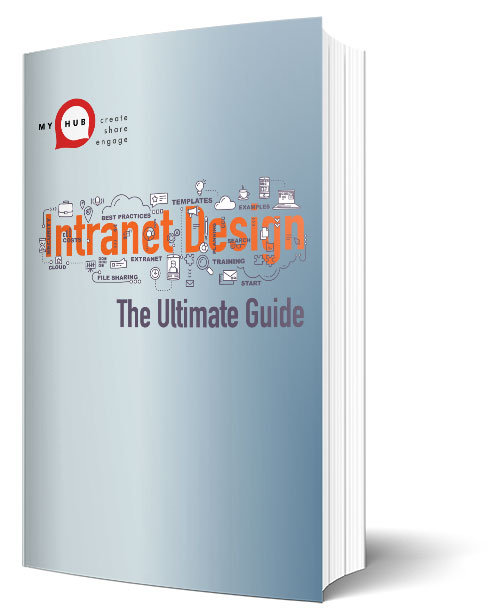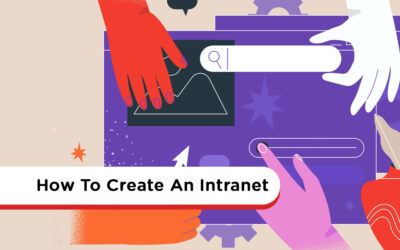The Intranet Design Guide
Not sure where to get started in designing your intranet?
Check out our easy step-by-step guide below.
Let us guide you through the process.

Intranet Design Made Simple

Deciding to go ahead with an intranet was the easy part, right? After all, whether it’s improved communications, more streamlined processes, or easier access to information, the intranet ticks all the boxes.
However, designing your intranet can be a daunting task.
There are many decisions to be made around the type of intranet, hosting options, organization, structure, plus content, and design. With so much to think about, it can be tough to get started.
And if technology isn’t really your thing, it can be even harder to kick-start your intranet. That’s where this intranet design guide comes into play.
So, if widget, cache, and malware sound like another language, then this guide is for you! Written in simple-to-understand and jargon-free terms, the design guide is non-technical. And where technical language is unavoidable, we clearly define what we mean.
This guide will show you that designing an intranet is a simple task. In fact, it’s so easy, you won’t need IT backup or a college degree in computers!
Click here to download this guide in PDF format
Step-By-Step Intranet Design Support
The guide is a comprehensive resource, covering everything you need to know about intranets. We provide helpful insights at every stage, from different intranet types and hosting options to security and training.
And we also look at all the latest intranet design best practices. This resource includes lots of practical examples and visuals that will excite and inspire you.
What’s Included In This Intranet Design Guide
Who Should Read This Guide
The design guide is an essential resource for anyone planning to implement a new intranet. It’s also required reading if you are looking to revitalize, revamp, or refresh an existing intranet.
Perhaps you are in the market for an intranet provider to help you realize your vision. The design guide can help you make a winning selection.
Written for the non-technical person, this resource will also support HR or Marketing staff tasked with implementing an intranet.
Why Intranet Design Is So Important
Before we move on, it’s essential to understand why intranet design is so important.
Your intranet’s overall look and feel has the power to grab users’ attention and draw them in. It can spark creativity and foster collaboration. It can connect employees and turn the everyday task into something engaging and fun.
However, the stakes are high. A poorly designed intranet will have the opposite effect. A confusing, overloaded, and ugly intranet will see staff switch off. It’s a wasted opportunity as well as investment.
With so much to lose, getting your intranet design right has to be a priority.
No Two Intranets Are Alike
When it comes to design, there is no one-size-fits-all intranet solution. Sure, there will be similarities. It could be layout, functionality, or scope. However, every organization is different, and so too is their intranet.
Furthermore, staff members will use the intranet differently depending on their job roles and team functions.
Employees use the intranet mainly to source information or collaborate with colleagues. Managers, however, use the intranet to engage workers with targeted communications.
Your intranet design needs to satisfy all the varying needs of employees.
And it also needs to meet the challenges of the modern digital workplace.
The global Covid-19 pandemic has fast-tracked the shift towards remote working. Companies have to pivot and rethink how they engage with their workforce in today’s rapidly changing environment.
And they need to ensure employees have the tools available to remain productive even when working from home.
A mobile intranet is a minimum requirement. In fact, it’s not so much a requirement as an expectation. Whether staff are on the go or working from home, they expect to continue working.
Versatile and flexible, the intranet is capable of meeting these competing demands. And your intranet design should make this vision a reality.
Intranet Templates Make Design Easy
And if you are pushed for time, then intranet design templates could be the perfect solution. This guide takes you through all you need to know.
In short, intranet templates come with in-built coding plus a basic design and graphics. The setup wizard makes it quick and easy to implement your customized intranet. Upload your logo, branding, and corporate colors to really put your company stamp on the intranet. And the good news is the intranet provider has already extensively tested the functionality. And that’s one less major headache for you to worry about.
Therefore, design templates are a popular choice if you need to get your intranet up and running quickly.
Let Us Guide You
Use this guide to make your intranet deployment a smoother and quicker process.
Essential reading for those starting to deploy an intranet, this resource will also help businesses looking to revamp an existing intranet.
Either way, we understand the challenges that are involved. And you get the benefit of our experience as we guide you through the process from beginning to end.
So, let’s get started.
Intranet Design Infographic
If you would like an overview of our intranet design guide, we have created a PDF infographic file summarizing the main points available here.
Further Reading
This further reading list will be an invaluable resource as it takes you through everything you need to know. We give you the benefit of our considerable experience in developing intranets and provide simple, easy-to-follow explanations, insights and advice.
Use this list to explore the latest intranet design best practice principles. Find out how pre-built intranet templates could well be the solution every time-pressed business owner is looking for. Discover how to ensure your intranet design is mobile friendly and optimized for use on smartphones and tablets. And learn about how to make your intranet interactive and fun so that users readily engage with the platform making for a more efficient and effective workplace.
These are just some of the insights available in this category so why not have a browse or use the search functionality to explore more about intranet design. With our comprehensive knowledge bank, you’ll soon discover that designing an intranet isn’t the mammoth task that perhaps you first thought it was.
50 Intranet Benefits You Need To Know About
In today’s digital workplace, effective communication and streamlined processes are paramount. The blog post from MyHub Intranet outlines 50 significant benefits of implementing an intranet, emphasizing its role in enhancing internal communication, fostering collaboration, and improving overall productivity.
Key advantages include stronger internal communication through centralized newsfeeds and multimedia capabilities, facilitating two-way communication via blogs and surveys, and personalized content delivery to keep employees engaged. Additionally, intranets serve as a single source of truth, aiding in quick information retrieval and efficient knowledge management.
By breaking down departmental silos and promoting teamwork through dedicated forums and project spaces, intranets not only streamline operations but also cultivate a cohesive organizational culture. Implementing an intranet like MyHub can lead to measurable improvements in employee engagement and operational efficiency.
10 Employee Appreciation Ideas On A Budget
Employee appreciation is a powerful tool for boosting morale, increasing engagement, and reducing turnover. However, many organizations believe that meaningful recognition requires a significant financial investment. In reality, small, thoughtful gestures can have a profound impact on employee satisfaction.
Implementing budget-friendly appreciation strategies, such as personalized thank-you notes, shout-outs during team meetings, or organizing casual lunch gatherings, can make employees feel valued without straining the company’s finances. These actions not only acknowledge individual contributions but also foster a culture of recognition within the organization.
By integrating regular appreciation practices into the workplace, companies can cultivate an environment where employees feel respected and motivated. This approach leads to improved performance, higher retention rates, and a more positive organizational culture.
Quality Assurance Methods: Maximize Performance With An Intranet
Maintaining consistent quality is vital for any business looking to meet customer expectations and build long-term success. This blog post dives into the fundamentals of quality assurance (QA), explaining its importance, distinguishing it from quality control (QC), and highlighting its role in customer satisfaction, brand reputation, and operational efficiency.
The article outlines the most effective quality assurance methods—including Six Sigma, benchmarking, process checklists, and ISO accreditation—and emphasizes how intranet technology can enhance their implementation. Through centralized documentation, real-time collaboration, integrated feedback tools, and digital checklists, intranets can simplify and scale QA systems across your organization.
It also explores key components of a successful QA strategy such as staff training, customer feedback integration, and data management. By using a cloud-based intranet solution, businesses can automate workflows, support continuous improvement, and ensure compliance—ultimately delivering a more reliable and refined experience for customers and teams alike.
Employee Engagement in HR: The Essential Guide!
Employee engagement is one of the most powerful drivers of organizational success, yet global studies reveal that only 15% of employees are actively engaged at work. This comprehensive guide explores how HR professionals can transform that statistic by leading meaningful engagement strategies. Starting with a clear definition—employee engagement as the emotional connection employees feel toward their work and company—the article outlines its direct impact on performance, customer satisfaction, and staff retention.
The post dives into the most influential engagement drivers: inspirational leadership, role clarity, alignment with business goals, and recognition. HR’s role is positioned as both strategic and operational—designing manager training programs, reshaping performance reviews, and embedding engagement in company culture. The guide emphasizes that engagement isn’t about expensive perks, but about meaningful recognition, transparent communication, and helping employees feel valued and empowered.
To close, the article outlines how HR can measure engagement through staff surveys, exit interviews, HR metrics, and intranet platforms. With the right tools and mindset, HR leaders can create a workplace where employees are motivated, loyal, and aligned with the company’s mission. MyHub’s intranet platform is highlighted as a practical tool to implement these strategies effectively.
CEO Blog: Mastering Communication with Staff and Clients
In today’s fast-paced business environment, effective communication from leadership is more crucial than ever. A CEO blog provides a powerful internal communication tool that connects employees directly with top leadership. By regularly publishing transparent and engaging content, CEOs can bridge gaps in understanding, strengthen trust, and cultivate a sense of inclusion across all levels of the organization.
Beyond simple messaging, a CEO blog also plays a vital role in reinforcing company values and culture. It creates a platform to celebrate achievements, explain strategic changes, and align the team with business objectives. With the added ability to invite two-way conversations via comments or polls, it becomes a dynamic channel that promotes openness and fosters collaboration.
To ensure long-term success, CEOs should focus on authenticity, consistency, and accessibility. Whether you’re sharing personal reflections or important company updates, an authentic voice resonates more deeply with staff and clients alike. Hosting your blog on the company intranet ensures easy access, while short, regular posts keep engagement high. The result? Stronger leadership presence, a more connected team, and a thriving organizational culture.
Mindfulness In The Workplace: Practical Ways To Introduce It
Mindfulness in the workplace is gaining popularity, with major companies like Google and Nike adopting mindfulness practices to boost employee well-being and productivity. At its core, mindfulness means staying present and focused, avoiding distractions from past or future concerns. This approach helps employees concentrate on the task at hand, reduce stress, and enhance overall performance. The concept stems from Buddhist teachings but has evolved into a powerful tool for modern professionals.
The benefits of mindfulness in the workplace are wide-ranging. It builds resilience, strengthens emotional intelligence, boosts creativity, and enhances personal relationships between colleagues. Employees who practice mindfulness are better able to manage stress and improve focus, leading to better work quality and healthier work dynamics. Mindfulness encourages an empathetic, innovative, and resilient workforce, improving both individual and team performance.
To successfully introduce mindfulness in the workplace, employers should start by incorporating small, manageable practices. Simple exercises like mindful breathing or offering a quiet space for meditation can make a big difference. Ensuring that mindfulness is optional and not mandatory is key to its success, as forcing participation can lead to resistance. By creating a supportive environment for mindfulness, businesses can foster a more balanced and productive workforce.
Startup Intranets: Six Reasons Why Your Company Needs One
Many startups might think that an intranet is a luxury reserved for large corporations, but the truth is, a cloud-based intranet can provide startups with a competitive advantage from day one. By streamlining communication, managing information, and offering seamless integration with tools like Google Docs and Microsoft Office 365, an intranet helps startups stay organized and efficient. It provides a single platform for collaboration, making it easy for remote workers to stay connected and for information to be shared across the team in real-time.
An intranet also offers invaluable benefits beyond organization. By providing 24/7 access, the cloud-based platform ensures that startup founders and employees can stay on top of tasks and updates from anywhere, whether they’re working from home, a coffee shop, or traveling. Additionally, having an intranet in place signals professionalism to potential investors and new hires, boosting confidence in the company’s long-term viability and organizational structure.
The flexibility of a startup intranet is another key advantage. It can scale alongside the business, adding new pages, modules, or functionalities as needed. This adaptability, combined with cost-effective monthly subscriptions, ensures that the intranet grows with your startup without unforeseen costs. By establishing efficient communication and collaboration from the outset, a startup intranet helps foster a strong company culture, setting the foundation for future success.
Cultural Audits: How To Assess Your Workplace Culture
Workplace culture plays a crucial role in shaping employee engagement, organizational behavior, and long-term business success. Yet many leaders struggle to define or evaluate their company’s culture in a structured way. This blog post introduces the concept of cultural audits—systematic evaluations that help identify whether a company’s culture aligns with its values and strategic goals.
The article breaks down the audit process into three stages: assessment, analysis, and recommendations. It outlines practical tools like focus groups, staff surveys, and document reviews, which help uncover both visible and hidden aspects of company culture. It also provides sample audit questions to guide internal reviews and elicit honest feedback from employees and stakeholders.
By conducting regular cultural audits, organizations gain actionable insights that can drive positive change. Whether performed internally or with the help of external consultants, cultural audits offer a clear roadmap to building a healthier, more inclusive, and performance-driven workplace. The post concludes with a call to action encouraging businesses to embrace cultural audits as part of their ongoing development strategy.
Onboarding LMS: Simplify Employee Onboarding with MyHub
Effective onboarding is a pivotal moment for new employees — shaping their experience, productivity and likelihood to stay. The blog argues that traditional onboarding methods (paper forms, disconnected tools, manual check-lists) often fail because they don’t align with how employees actually work. Embedding an onboarding Learning Management System (LMS) inside your intranet fixes this by placing training, resources and workflows where teams already spend time.
With an onboarding LMS built into your intranet, organizations can centralize learning content, automate key tasks (form completions, policy acknowledgements, role-based training), and track progress with real-time reporting. This ensures new hires can find what they need, complete required modules, and engage with the company culture—all without bouncing between systems. The blog highlights key features like personalized learning paths, automated assignments, seamless access to documents and team communication as essential for new-hire success.
The result is two-fold: first, a smoother, faster ramp-up for newcomers (less confusion, better clarity, stronger integration); second, reduced administrative load for HR and team leads (fewer follow-ups, better visibility, stronger metrics). The blog emphasises that onboarding isn’t just a one-time event but the beginning of ongoing development—so choosing the right LMS strategy inside the intranet sets the stage for long-term engagement and growth.
SaaS LMS: Smarter Learning for the Modern Workplace
A SaaS LMS (Software as a Service Learning Management System) is a cloud-based platform that allows businesses to deliver training, onboarding, compliance programs, and professional development without the complexity of on-premise software. Unlike traditional LMS solutions, SaaS LMS platforms are accessible from any device, provide real-time updates, and scale effortlessly as organizations grow, making them ideal for modern, distributed teams.
Modern companies face challenges with disconnected tools, scattered learning materials, and inconsistent training processes. A SaaS LMS solves these issues by centralizing learning content, policies, and communication in one platform. Employees can access courses anytime, managers can track progress and completion rates, and HR teams gain actionable insights to close skill gaps efficiently—all while reducing administrative workload.
By integrating a SaaS LMS into the company workflow, businesses create a seamless learning experience that supports engagement, productivity, and continuous development. Features like AI-assisted course creation, personalized learning paths, automated reporting, and collaborative tools ensure employees stay motivated and aligned with organizational goals. This approach transforms training from a task into an integral part of everyday work.
Business LMS: Smarter Learning, Seamlessly Built Into Your Intranet
A Business LMS is a purpose-built platform that centralizes learning within the workflow of employees. Unlike standalone tools, it integrates training, policies, and professional development into the same intranet used for communication, documents, and team collaboration. This approach reduces scattered resources, paper-based workflows, and disconnected teams, making learning easier to access, measure, and apply.
Modern workplaces demand flexible, measurable, and engaging learning experiences, especially in hybrid or remote setups. A Business LMS supports the full employee lifecycle—from onboarding and compliance to leadership development—while providing personalized learning paths, automated reminders, and performance tracking. When embedded in the intranet, learning becomes a seamless part of employees’ daily routines, helping organizations foster continuous growth and skill development.
MyHub’s all-in-one intranet + LMS transforms corporate learning by combining intuitive navigation, AI-assisted course creation, integrated reporting, and workflow tools. Small businesses benefit from simplicity and scalability, while enterprises enjoy powerful features for compliance, engagement, and knowledge management. By connecting learning with communication and collaboration, MyHub builds a culture where development happens naturally, boosting both skills and workplace culture.
How To Create An Intranet: A Step By Step Beginner’s Guide
Launching an intranet can feel overwhelming—especially when the options seem technical and the stakes are high. This guide starts by demystifying what an intranet is: a secure internal network where employees collaborate, share resources and communicate effectively. It then explores the main types of intranet solutions—custom-built, off-the-shelf, or cloud-hosted—so organisations can choose an option based on their needs, budget and technical capacity.
The next section drills into the step-by-step process. It begins with assembling the right project team (cross-department representation and leadership support). Then it emphasises defining clear goals and conducting a needs analysis (what problems you want the intranet to solve). Afterwards comes selecting the software solution, designing the site architecture and content strategy, and building the intranet with branding and usability in mind. The guide offers practical design tips like the “six-six rule” (max six pages per section, six items per page) and emphasises mobile-responsiveness and simple navigation.
The final part covers launch and long-term success: pilot testing with a subset of employees, training users and champions, creating buzz around the go-live, and establishing governance, feedback loops and continuous improvement to keep the intranet relevant. The message is clear: the intranet isn’t just a project you check off—it’s a lasting part of your digital workplace that evolves with your business.
The Complete Intranet Design Guide: All You Need To Know
In this guide, MyHub outlines a structured approach to designing an intranet that truly works for users — not just IT. The process begins with defining the purpose: who the intranet serves, what problems it solves, and how success will be measured. Without this foundation, the design risks being misaligned or under-used.
Next the guide walks through key design components: branding (logo, colours, tone), site architecture (navigation, page hierarchy, discoverability), content strategy (what will live on the intranet, how often it’s updated, who owns it), and user experience (mobile access, intuitive layouts, search). Each step is explained in actionable terms, making the technical feel accessible to non-IT stakeholders.
Finally, the guide emphasises launch and adoption: creating a phased rollout plan, training champions, gathering feedback, measuring usage metrics, and maintaining momentum after go-live. The idea is that a successful intranet isn’t built once and forgotten — it evolves through use, stakeholder input, and continuous improvement.
81 Inspirational Employee Engagement Quotes
This article presents a collection of 81 carefully selected quotes about employee engagement, drawn from leadership figures, business thinkers, and motivational voices. It begins by explaining that while quotes may seem simple, their power lies in context—used thoughtfully they can underscore culture, values, and recognition within the workplace.
The piece is structured into themed sections — for example: quotes on the importance of engagement, for managers, for retention, and for recognition. Each section offers sample quotes that organisations can embed into intranet pages, newsfeeds, celebration boards or team-chat channels to reinforce engagement. It also includes guidance on how not to over-use quotes: the risk being that too many or inappropriate use can dilute sincerity.
Finally, the article emphasises that quotes are a tool — not a substitute for action. They work best when paired with tangible engagement strategies: clear communication, recognition, purpose-driven work, feedback systems and intranet features that support visibility and belonging. In other words, use the quotes to amplify culture, but keep engagement real.
Best Company Intranet Names: Ideas and Examples
Choosing the right name for your intranet is more than just a branding exercise; it’s about creating an identity that resonates with your team and reflects your company’s values. The MyHub article emphasizes the importance of a thoughtful intranet name, explaining that it can inspire, motivate, and engage users, while also conveying your brand’s vision and values. A well-chosen name humanizes the intranet and helps distinguish it from other company systems.
The blog provides a curated list of ten creative intranet names to spark inspiration. These include “Work-e-pedia,” “Exchange,” “The Grid,” “Pulse,” “Elvis,” “The Hub,” “Gateway,” “Insite,” “The Forum,” and “Planet.” Each name is accompanied by a brief explanation of its potential appeal and relevance, offering a diverse range of options to suit various organizational cultures and objectives.
Beyond the list, the article offers practical advice on how to approach the naming process. It suggests considering your intranet’s goals, your company’s culture, and how employees will use the platform. The blog also recommends involving staff in the naming process to foster a sense of ownership and engagement, ensuring the chosen name resonates with the entire organization.















